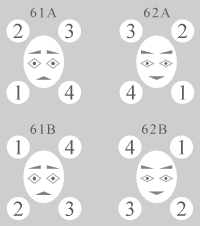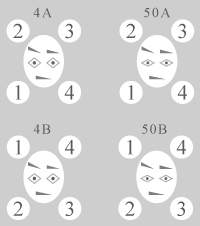-
In socionics there is a representation about subtypes or otherwise to tell
about additional types which correspond with the basic psychological types of
Myers-Briggs Type Indicator that in aggregate forms structure of a human
personality. Namely according to this representation each person possesses
psychological type and a subtype that forms a complex design in which it is
possible to consider 16x16=256 variants of mathematical combinations of 16 basic
types and 16 subtypes.
But in view of analytical physiognomy there is a smaller number of variants
according to which displays of psychological types are interconnected with
physiognomic parameters of human faces. In essence the analytical physiognomy
allows to systematize mathematical combinations of psychological types and
subtypes which are shown according to ratio of facial features with symbols of
analytical physiognomy, that is necessary to consider during the analysis of
psychological interrelations and transactions of mental functions.
The greatest number of subtypes or otherwise to tell variants of psychological
types are peculiar to harmonious types of analytical physiognomy.
For example, interrelations of mental functions of 61st and 62nd harmonious
types.
 |
Letters A and B designate different displays of
psychological types. The type 61A is shown as intuitive-logic. The type 61B is shown as logic-intuitive. The type 62A is shown as sensory-ethical. The type 62B is shown as ethical-sensory. Namely 61st psychological type of analytical physiognomy can be shown as intuitive-logic or as logic-intuitive, and 62nd psychological type can be shown as sensory-ethical or as ethical-sensory. Besides 61st type can be shown as sensory-ethical or as ethical-sensory, and 62nd type can be shown as intuitive-logic or as logic-intuitive if unobvious mental functions are shown as obvious, and in essence if 61st type changes in 62nd or 62nd type changes in 61st, that is peculiar to harmonious types. And in essence harmonious types can be shown as all 16 base types of Myers-Briggs Type Indicator. But it is necessary to consider that modifications of psychological types are connected with mobile features of a human face and if facial features are motionless then variants of modifications of harmonious types can be limited as variants of explicit or contrast types. |
-
In parities 61A-62A or 61B-62B the first strong function of one type
coincides with the fourth non-actual function of the second type that can cause
contradictions, but in essence is the reason of coordinated interrelations as
one type is competent in spheres which are irrelevant for the second type. And
also in parities 61A-62A or 61B-62B the second actual function of one type
coincides with the third weak function of the second type that is the reason of
coordinations of psychological interrelations as one type operates in spheres in
which the second type realizes incompetence, and in essence one type carries out
actions which cannot be carried out by the second type.
But in parities 61A-62B or 61B-62A the first strong function of one type
coincides with the third weak function of the second type that causes
contradictions as one type is competent in spheres of a life where the second
type realizes incompetence. And also in parities 61A-62B or 61B-62A the second
actual function of one type coincides with the fourth non-actual function of the
second type that causes contradictions as one type operates in spheres which are
irrelevant for the second type.
In the shown example psychological interrelations are coordinated or are
inconsistent, but as a whole interrelations of harmonious types of analytical
physiognomy are compromise as possible modifications of types compensate
contradictions, and also obvious mental functions counterbalance contradictions
that is not peculiar to contrast types.
For example, interrelations of mental functions of 4th and 50th contrast
psychological types of analytical physiognomy.
 |
The type 4A is shown as intuitive-logic. The type 4B is shown as logic-intuitive. The type 50A is shown as intuitive-logic. The type 50B is shown as logic-intuitive. Namely both types are shown as intuitive-logic or as logic-intuitive. Feature of contrast types consists that active mental functions exclude opportunities of modifications as passive functions are not shown as active. For example, passive ethics of 50th type cannot be shown as active and accordingly cannot be shown as leading function, and as a result 50th contrast type of analytical physiognomy does not change in other types. But it is necessary to consider that modifications of types are connected with mobile facial features, and consequently if passive mental functions correspond with mobile features then modifications are possible. The detailed information on modifications of psychological types of analytical physiognomy according to mobile features of a human face look on following page. |
In parities 4A-50A or 4B-50B leading and minor mental functions are
identical, that is the reason of identical or otherwise to tell the interfaced
interrelations, as both types are competent or realize incompetence in identical
spheres of a life.
In parities 4A-50B or 4B-50A the first strong function of one type coincides
with the second actual function of the second type that is the reason of
indifferent or otherwise to tell neutral interrelations, as one type is
competent in spheres where the second type carries out competent actions. And
also in parities 4A-50B or 4B-50A the third weak function of one type coincides
with the fourth non-actual function of the second type, that also is the reason
of indifferent interrelations as one type realizes own incompetence in spheres
which are irrelevant for the second type.
In total during the analysis of psychological interrelations and transactions of
mental functions it is possible to adhere to a rule according to which
concurrences of 1-4 and 2-3 functions are coordinated, concurrences of 1-2 and
3-4 functions are neutral, concurrences of 1-3 and 2-4 functions are
inconsistent, concurrences of identical functions are interfaced, but more
detailed information on parities of leading and minor mental functions in
intertype attitudes look on pages of the site
www.numeralgame.64g.ru.
The following page describes modifications of psychological types of analytical physiognomy according to mobile and motionless features of human faces.
-